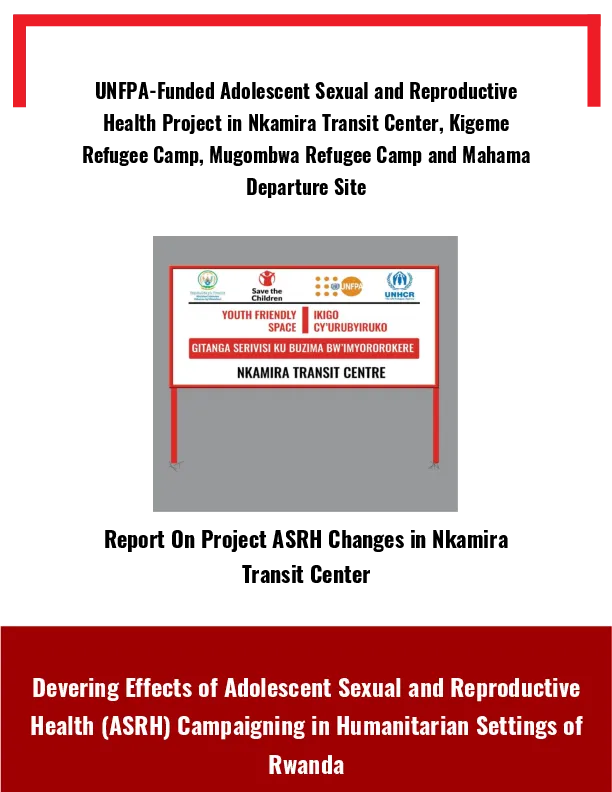
Publication year:
2023
English
Format:
PDF (488.5 KiB)
Publisher:
Save the Children International,Save the Children Rwanda
This report highlights the changes occurred throughout ASRH awareness raising campaigns in the new transit center of Nkamira, which hosts more than 10 thousand of asylum seekers in Rwanda, following the devastating armed conflicts in the Eastern Province of DR Congo.
This project learning assessment was carried out in a bid to understand the extent to which ASRH awareness raising campaigns have impacted the adoption of ASRH behaviors in Nkamira TC (new site for SCI Rwanda office).
Operationally, this learning assessment aimed to check the status of youth information following ASRH raising awareness campaigns on the use of and willingness to use condoms against risky sexually transmitted infections. Additionally, the assessment sought to learn how best youth sensitized on ASRH are empowered to timely report on gender-based violence.
The questionnaire was developed and gathered ideas of respondents in effort to check the progress towards project outcomes. Desk review was made and complemented by the most significant stories from people who participate to ASRH campaigns. A total number of 120 (54% of females and 46% of males) participants were randomly selected to give them equal chances for participation as well ensuring gender perspectives during the project assessment.
Findings revealed that adolescents reported that condoms are reliable means for the protection against STIs (95.6%). Only 29% of the interviewed adolescents and youth reported to have used a condom in the last three months preceding the assessment. From respondents’ perspectives, reporting using condoms might be seen as reporting their privacy information and this could also contribute to less condom usage in the camp because they do not want to disclose their privacy. The will require intensive awareness raising to ensure they are using condoms as required for the prevention of STIs and unwanted pregnancies. The majority (91%) of adolescents reported meeting more frequently with ASRH peer educators is beneficial in sharing private and secret lives for support.
The assessment has demonstrated that few numbers of respondents (4.4%) have experienced any form of violence in past 12 months. Interestingly, of those experienced different forms of violence majority of them (62.5%) have reported such violence for support to concerned authorities. However, less half of them (40%) were satisfied with GBV services provided. Findings revealed that almost a third of respondents have experienced GBV before they were settled to transit center and on their move to exile from DR Congo.
Adolescents reported neighbors (38%) and others (38%) including; Armed rebel group called kata nyama in DRC, Nyatura in DRC and DRC army, parents/caregivers and children themselves reported (13%) respectively. however, SC is not implementing GBV case management and some of the violence cases happen outside the country, SC supports clinical management of GBV or for referral cases for further support. It is evident that parents, children and other community members are involved in GBV cases. This calls for multi-sectoral collaboration and building synergies with different partners to enhance violence case reporting but also increase dissemination and awareness raising on GBV reporting channels as well as empowering the community through the existing community structures for prevention, identification and reporting.
With reference to the above findings and in line with the objectives of this assessment, it’s recommended to:
Use of multi-sectoral approaches to ASRH awareness raising campaigns amidst settling arrivals of asylum seekers by identifying ASRH needs through community-based structures like ASRH peer facilitators, CHWs, local/religious leaders etc.;
Expand series of ASRH communication channels by using local media and other information sharing mechanisms like brochures, by community members to extend knowledge of participants about ASRH programs;
Engage parents of youth and community members in ASRH interventions, as appropriate community of practice for parental/adolescent participation through awareness raising;
Engage adolescents in the design, delivery and monitoring of ASRH campaigns and empower generations of peer educators to deliver these interventions;
Engage adolescent-led organizations, humanitarian donors, faith-based organizations, governmental entities, NGOs and CBOs in jointly building stakeholders-inspired ASRH campaigning that target youth including youth with disabilities;
Work closely with adolescents to ensure that services are accessible, acceptable and appropriate for all adolescents, including high-risk specific groups like refugees and asylum seekers with disabilities, youth diverse faith and different gender orientations.
Read full abstract
English
1 Documents
Authors
Format
Content type
Country
Region
Rights
© Author/Publisher
Keywords
If you have noticed a document assigned to the wrong author or any other inaccuracies, let us know! Your feedback helps us keep our data accurate and useful for everyone.
Share
Link